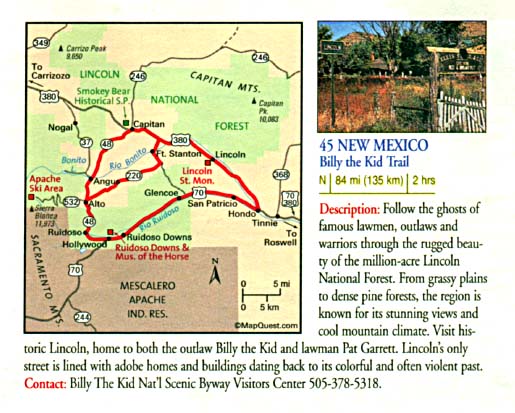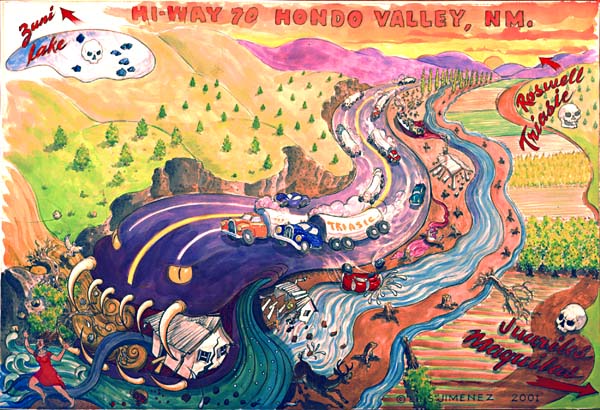Request Safe Improvements Instead
"The incomplete Draft Environmental Impact Statement has been finalized, but none of the design concepts provided by VCPC consultant Walter Kulash and none of the biologists' comments appear in it. Fifty comments from people who live in the community do not appear. [Susan] Jimenez [of the VCPC] points out, 'The Final Environmental Impact Statement is an inadequate study, slanted to the four lane road they wanted at the start.' Meanwhile, the highway department gets ready to widen the highway; piles of dirt are appearing along the road."
--Excerpt from, "Hondo Valley: Cultural Treasure or Sacrificial Landscape?" by Joanne McEntire, NUESTRO PUEBLO ~ SPRING 2002
--To Most Endangered Places
--To map / description, from America's Byways, FHWA--
*--To Download EIS & Comment--*
--Painting © Luis Jimenez 2001 (available as poster: See VCPC contact information below)
Hondo Valley--A "Most Endangered Place"
The New Mexico Heritage Preservation Alliance (NMHPA) announced their Most Endangered Places this January and Hondo Valley is one of the ten listed.
The Hondo Valley in Lincoln County is considered significant as an endangered place. It was shaped as a cultural landscape by Hispanic farmers and ranchers beginning in the 1850s, the Hondo Valley gained fame as a result of the Lincoln County War of the 1880s. Through the notoriety of that war and its notorious folk hero, Billy the Kid, the landscape and landmarks of the Hondo Valley have assumed a key place not only in New Mexico history but in the representation of the American West in popular culture.
In the 20th century, the Hondo Valley became an internationally known visual representation of New Mexico through the work of leading 20th century artists who called it home. An adapted 1930s schoolhouse today serves as home and studio to internationally acclaimed artist Luis Jimenez. San Patricio grew famous with Peter Hurd, son-in-law of N.C. Wyeth. The work of Hurd, Henriette Wyeth, John Meigs, Michael Hurd, Carol Hurd Rogers, Peter Rogers and others has spread knowledge of the Hondo Valley's cultural landscape. The hand-dug communal acequia system continues to operate today, not only as irrigation but also as a social system and a traditional and legal means of allocating a scarce resource.
The threat to this landscape is the widening of U.S. Highway 70, now the New Mexico Department of Transportation's highest priority. It would increase the volume and speed of traffic, increase air and water pollution, require a greater number of road cuts, endanger the watershed and riparian habitat, and destroy or damage tree lines, acequias, fruit stands and certain older adobe buildings.
FOLLOW-UP NOTE
According to Susan Jimenez, an active member
of the citizens' group, "We would like the Hondo Valley
to be designated as a rural or cultural landscape. The views
Hurd painted are still alive today, however being threatened
by the "improved" highway. We have organized as a grass
roots community organization, and have tried to talk to the transportation
department, who has hired Parsons Brinkerhoff, a engineering
consulting firm." Still, the citizens are not getting their
concerns and issues heard and they continue to seek support from
other New Mexicans and design consultants.
US 70 HIGHWAY EXPANSION--Update, Winter 2003
From Heather Anderson, NMELC Staff Attorney
New Mexico Environmental
Law Center
0ur client, the Valley Community Preservation Commission (VCPC) appeared before Judge LeRoy Hansen in the New Mexico Federal District Court on November 20, 2002 to ask for a preliminary injunction against the Federal Highway Administration (FHWA).
In its complaint, the VCPC and other individual plaintiffs claim that the FHWA violated the National Environmental Protection Act and Section 4(f) of the Department of Transportation Act. First, it approved the project despite conflicts of interest with the engineering firm that completed the environmental studies and was hired to act as consultants over the project if a "build" alternative was selected. Second, the FHWA only looked in the very narrow right-of-way to determine whether the four-lane highway would destroy any historical or cultural features of the Hondo Valley. The FHWA determined there would be no negative impact, and as a result of this narrow, illegal review, it never determined whether there was an alternative that would minimize the impacts.
At the hearing, the VCPC argued that although the adequacy of the FHWA's actions should be judged on the administrative record, because the FHWA had not completed requisite impact studies, it is necessary for the court to look at information not contained in the administrative record but that demonstrates just how much the FHWA actually neglected to take into account.
The injunction, if granted, would have stopped the US 70 expansion project until the FHWA adequately studies the project impacts on cultural and historical resources in the Hondo Valley. Unfortunately, judge Hansen denied our request for the preliminary injunction pending a trial on the merits of the case. The VCPC and individual plaintiffs have appealed the denial of the injunction to the 10th Circuit Court of Appeals. Briefing is complete and we are waiting to hear from the 10th Circuit.
ARCHIVES--REPORTS FROM THE PAST:
US 70 HIGHWAY EXPANSION--From Green Fire
Report, NMELC, Summer 2002
Heather Anderson, NMELC Staff Attorney
Four days after the comment period on the Final Environmental Impact Statement for the US 70 Milepost 302 to Ruidoso Downs project ended, the Federal Highway Administration (FHWA) issued a Record of Decision (ROD) and signed a contract for the construction of a four lane highway through the Hondo Valley. The cultural resources report outlining historic properties that may be impacted by the project was, and remains, incomplete.
Our client, the Valley Community Preservation Commission (VCPC) is coordinating its efforts against the expansion of US Highway 70 between Milepost 302 (two miles east of Riverside, New Mexico) and Ruidoso Downs with the New Mexico Heritage Preservation Alliance and the National Trust for Historic Preservation.
Although the FHWA and the New Mexico State Highway and Transportation Department (NMSHTD) are currently discussing what to do when the project reaches known or undiscovered historical properties that will be impacted by the project with the various interested parties, the VCPC is concerned that these conciliatory efforts are not adequate. The process (programmatic agreement) only allows for public input on properties discovered in the future. The cultural resources studies completed prior to the date of the programmatic agreement discussions--without public input--will not be open for review. The NMSHTD and the FHWA are still researching newly discovered historical resources in the valley.
In addition - the case will be transferred back to NM where a new judge will be assigned.
------------
US 70 HIGHWAY EXPANSION--From 6/11/02
Heather Anderson, NMELC Staff Attorney
The Hondo Valley is one of New Mexico's unique cultural resources. The original Hispanic settlers, and later settlers established a farming community dependent not only on the acequia and irrigation ditch system, but on the valley history and on the residents' close ties to one another. The integrity of this resource is now threatened by the expansion of US 70 through the valley.
The Valley Community Preservation Commission (VCPC) is coordinating its efforts against the expansion of US Highway 70 between Milepost 302 (two miles east of Riverside, New Mexico) and Ruidoso Downs with Gerald Ford, Troy Omness, Royce Griggs, the New Mexico Heritage Preservation Alliance, the Sierra Club, and the National Trust for Historic Preservation. Over the past several months, their efforts have focused primarily on concerns that water quality and quantity in the Hondo Valley are maintained, and on concerns that the historical properties in the valley be preserved. These issues are particularly difficult to address under the current design/build system chosen for the project, however, and it is under this circumstance that Context Sensitive Design for Highways is relevant to the VCPC's efforts.
Four days after the comment period on the Final Environmental Impact Statement for the US 70 Milepost 302 to Ruidoso Downs project ended, the Federal Highway Administration (FHWA) issued a Record of Decision (ROD) approving the construction of a four lane highway through the Hondo Valley. The cultural resources report outlining historic properties that may be impacted by the project was, and remains, incomplete. Although the FHWA and the New Mexico State Highway and Transportation Department (NMSHTD) are currently discussing what to do when the project reaches known or undiscovered historical properties that will be impacted by the project with the various interested parties, the VCPC is concerned that these conciliatory efforts are not adequate. The process (programmatic agreement) only allows for public input on properties discovered in the future. The cultural resources studies completed prior to the date of the programmatic agreement discussions and without public input, will not be open for review.
A high level of uncertainty about the actual impacts of the four-lane project prevails, and many Hondo Valley residents are unsure of how their properties will be specifically impacted. Most Hondo Valley residents own property with important historical characteristics. Although NMSHTD employees have promised individual residents that the project will not harm historical properties, most residents have not seen any specific plans. The highway design remains incomplete because of the selected design/build process, and the NMSHTD and the FHWA are still researching newly discovered historical resources in the valley.
Highway designs
must include and adequately address the public's needs and concerns.
The US 70 four-lane project and design accomplish neither. [For
more information, please contact the New Mexico Environmental
Law Center at (505) 989-9022.]

--From, America's Byways, All-American Roads & Scenic Byways, FHWA
